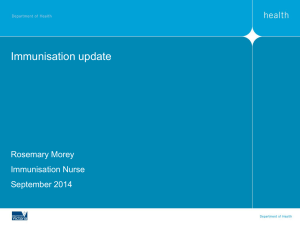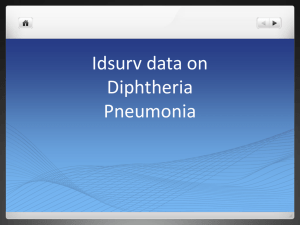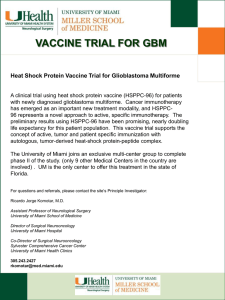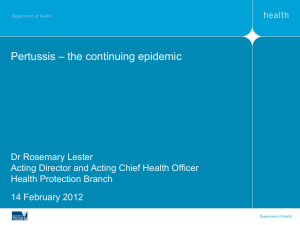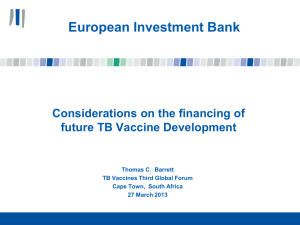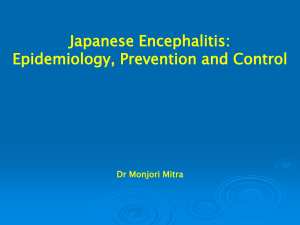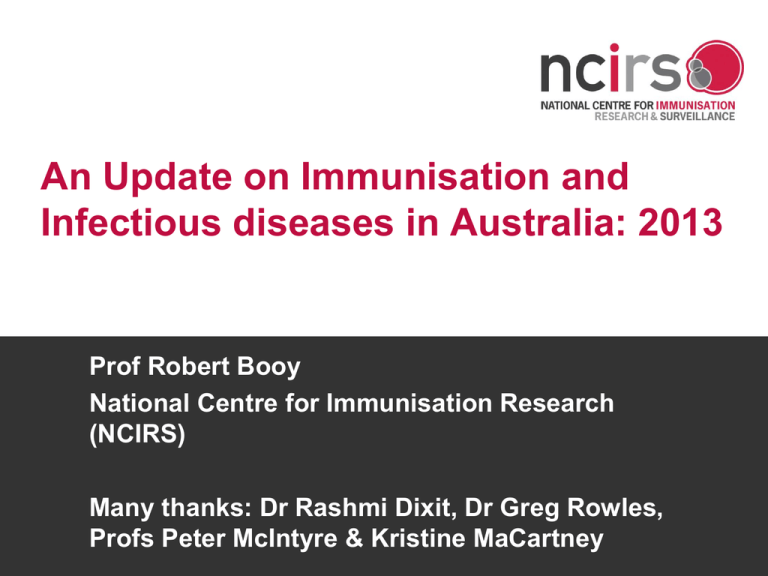
An Update on Immunisation and
Infectious diseases in Australia: 2013
Prof Robert Booy
National Centre for Immunisation Research
(NCIRS)
Many thanks: Dr Rashmi Dixit, Dr Greg Rowles,
www.ncirs.usyd.edu.au
Profs Peter McIntyre & Kristine MaCartney
Nigeria polio vaccinators shot dead in Kano
8 February 2013
http://www.bbc.co.uk/news/world-africa-21381773
Nine female polio vaccinators have been killed in
two shootings at health centres in northern Nigeria
Some Nigerian Muslim leaders
have previously opposed polio
vaccinations, claiming they could
cause infertility
One cleric told people that new
cases of polio were caused by
contaminated medicine
Nigeria is one of only three
countries where polio is still
endemic
Outline of talk
Some qanda at beginning and end
Pertussis: a real curly one..
Influenza: always something new under the sun
Rotavirus vaccine: yet again, the haves have more
HPV: the wizardry of Oz Ian Frazer
Measles: what, that old chestnut?
Varicella and Shingles.. On the downhill run
Pneumococcal disease
Polio
Meningitis, encephalitis: no time except #qanda
Five year-old
Behnam went
from a sniffle and
a headache at a
birthday party on
Saturday to
intensive care by
Monday
morning…..
Kids Research Institute Annual Report 2011 - 2012
The cause of encephalitis, or swelling of the brain, is still unknown in more than half
of cases. It can kill in hours and leaves many others with brain damage and other
major complications
Baby Button and Mother
www.ncirs.usyd.edu.au
The Herald Sun
Deadly whooping cough warning
March 14th, 2012
.
“3 week old infant caught pertussis from 2 year old
fully vaccinated sister”……
Learning points: suspect pertussis in neonates & test;
prolonged cough in older child, even if vaccinated
Weekend Gold Coast Bulletin Saturday, 02 April 2011
Bordetella pertussis: whooping cough
Vaccination began 1950s but pertussis still prevalent
1990-2008 data consistent with outbreaks every 3-5 years
• Prior to vaccine: every 2-3 years
present epidemic c.f. epidemics in 1997 & 2002:
- Longer & many more infections were reported 2009-12
- fewer deaths BUT same number of hospitalisations
• Australia had record 38,000 cases diagnosed in 2011
• Seven infant deaths in Australia 2008-11
• Notifications falling in 2012/3
Bordetella parapertussis: A related GNB
• Clinically milder
• Pertussis vaccine not effective
• Europe: up to 1/3 of “whooping cough cases”; less in Aus
Pertussis symptoms
Typical symptoms in children1,3
Atypical symptoms frequently in
adolescents/adults2
Paroxysmal cough
Sneezing
Post-tussive vomiting
Coryza
Inspiratory whoop
Low grade fever
Prolonged cough duration
(Mean duration 36–48 days)3
Non-specific cough
• Neonatal apnoea +/- cough/whoop
• If older child/adult1 may resemble URTI, bronchitis, sinusitis, asthma
• Consider if prolonged coughing: B. pertussis3
1.
2.
Cherry et al. Pediatr Infect Dis J 2005; 24(5 Suppl): S25–34;
2. Brooks, Clover. J Am Board Fam Med 2006; 19: 603–11; 3. Wirsing von König et al. Lancet Infect Dis 2002; 2:744–50
Reasons for recent outbreak
Vaccine refusal
• Refusal clusters promote spread
• However:
- in Australia 94% of 2y-olds UTD with vaccines
- Cases not confined to these communities
- most pertussis cases >one dose dTPa, many UTD!
More / better testing
• Increased clinical recognition
• Use of PCR testing much increased last 5 years
McIntyre and Wood: Pertussis Prevention in early infancy. Current Opinion in Infectious Diseases. 2009; 22; 215-223
Reasons for recent outbreak
Shorter period of protection / Waning immunity
• Neither natural nor vaccine immunity is lifelong
• Adults (?teens) & sibs are source of infection to infants
• Recent outbreak: pre-schoolers and primary schoolers
? Vaccine less effective: mutations in pertussis toxins
• No evidence of this (but looking: NCIRS study 2012)
2 doses required before significant protection
• Currently: significant immunity from 18/52 age (2/52 post dose 2)
• One dose probably ↓ death / ventilation
• Most deaths < 12/52 age
J Infect Dis. 2012; 205:1220-4 (Lan: senior author)
Newly Emerging Clones of Bordetella pertussis
Carrying prn2 and ptxP3 Alleles Implicated in
Australian Pertussis Epidemic 2008-2010 Octavia et al
A total of 194 Bordetella pertussis isolates collected 2008-10 were
typed by single-nucleotide polymorphism (SNP) analysis
Strains with 2 closely related SNP profiles carrying prn2 and ptxP3
from the recently emerged SNP cluster I predominated
The data suggest but don’t prove increasing
selection among the B. pertussis population in
Australia in favour of strains carrying prn2 and
ptxP3 under the pressure of acellular vaccineinduced immunity
But
"The vaccine is still the best way to reduce
transmission of the disease and reduce
cases, but it appears to be less effective
against the new strain and immunity
wanes more rapidly….”
said Dr Lan
Pertussis vaccination: benefits and risks
Opponents (“Anti-vaccinists”) argue pertussis vaccine
‘ineffective’ +/or ‘risky’
The DTPa vaccine: overwhelmingly safe and
effective
• Pre-vaccine 1940s: hundreds died, now death rate v low
• Encephalopathy (‘brain damage’)
- Dravet’s syndrome: genetic condition =
explanation for most cases of encephalopathy post
whole-cell pertussis vaccine
Berkovic SF. et al. De-novo mutations of the sodium channel gene SCN1A in alleged vaccine encephalopathy: a retrospective study. Lancet Neurology.
5(6):488-92, 2006 Jun
Tro-Baumann B. et al.A retrospective study of the relation between vaccination and occurrence of seizures in Dravet syndrome. Epilepsia. 52(1):175-8,
Effects of vaccination
For vaccinated person:
• Reduction in susceptibility to infection
• Reduction in disease severity
- ? Effect on transmissibility
• Reduction in infectiousness
For unvaccinated person:
• Reduced proportion of contacts infected
• Herd immunity
Evidence of vaccine on transmission.
Senegal household study
Index case: vaccinated vs unvaccinated
0.25
Secondary attack rate
0.2
0.15
The unvaccinated who
acquire pertussis are more
infectious, with a higher
secondary attack rate, than
the vaccinated.
0.1
0.05
0
Vaccinated
Unvaccinated
Status of index case
Halloran ME, Préziosi MP, Chu H. Estimating vaccine efficacy from secondary attack
rates. Journal of the American Statistical Association. 2003;98:38–46.
US Data
Pertussis deaths US 2000 – 2005: (N = 140 deaths)
Majority (n = 131) of fatalities were in infants
• Too young (<4 m) to be vaccine protected (n = 126)
Of deaths:
• 97% unvaccinated
• 1% had one dose of vaccine against pertussis
• 2% had 2 or more doses against pertussis
Conclusion: Vaccine protects against death.
Tiwari T. Reported pertussis-related deaths to the National Notifiable Diseases Surveillance system and the CDC in the
United States, 2000-2005. #82. Presented at: the 42nd National Immunization Conference; March 17-20, 2008;
Atlanta.
300
120
250
100
200
80
Well over 60% cases
by 16 weeks of age
150
60
100
40
50
20
0
0
0
2
4
6
8
10
12
14
16
18
20
22
24
26
28
30
32
34
Age at onset (weeks)
36
38
40
42
44
46
48
50
Cumulative percentage of cases
No. of hospitalised cases
Pertussis hospitalisations < 1 yr old: 1994 - 2008
Strategies for Infant Pertussis: Indirect protection
4 year old booster:
• ?4 yrs 3.5 yrs: as many pre-schoolers in recent outbreak*
• Not categorically shown to reduce infant pertussis
Universal adolescent / adult vaccine
- Recent data USA / Australia: adolescents do not transmit to infants,
unless teen parents
- mathematical models in American / European context demonstrate
pertussis spreads child-to-child, not often child-to-adult
• Immunity wanes after 5 yrs with DTPa/ dTpa: may need 10 yr boosters
Kandola K, Lea A, White W, Santos M. A comparison of pertussis rates in the Northwest Territories: pre and post acellular pertussis vaccine introduction in
children and adolescents. Can J Infect Dis Med Microbiol 2005; 16:271–274
Rohani P et al., Contact Network Structure Explains the Changing Epidemiology of Pertussis. Science magazine. 330 (6006): 982-985
Quinn H and McIntyre P. The Impact of adolescent pertussis immunisation 2004-2009: lessons from Australia. Bull World health Organ. 2011; 89: 666-674
Skoff TH et al. early Impact of the US Tdap Vaccination Program on Pertussis Trends. Archives Paediatr Adolesc Med Online January 2 2012
Strategies to address Pertussis: Indirect protection
Cocoon: mother (father +/- grandparents +/- childcare workers)
• Parents (mother) commonest source, but source often hard to identify
• APERT trial: reduced pertussis in adults
- Expected lower transmission; no field data
• Modelling: cocooning + regular / single booster ↓ infant pertussis
• Poor uptake despite parental support
- Funding / implementation support required
- Maternity hosp for mums; GPs for fathers /family [before delivery]
• HCW vaccination ↓ intensive care nursery outbreaks / cost effective
Current NCIRS study on effect of cocooning
McIntyre and Wood: Pertussis Prevention in early infancy. Current Opinion in Infectious Diseases. 2009; 22; 215-223
Ward JI et al. Bordetella Pertussis Infections in Vaccinated and Unvaccinated Adolescents and Adults, as Assessed in a National Prospective Randomized
Acellular Pertussis Vaccine Trial (APERT). Clin Infect Dis. (2006) 43; 151-157.
USA experience with cocooning: Key Points
“Cocooning can be Successful” in short-term..
• Demonstration projects
- Houston, TX – Ben Taub General Hospital
- Nevada - 18 birthing hospitals
• Important success factors
- “Champion” for the cause
- Donated healthcare provider time
- Free dTPa
Clark, Thomas. Centers for Disease Control and Prevention; NCIRS Pertussis Meeting; August 26, 2011
Five years later, is cocooning
working in the USA?
Not at a national level
Limited success vaccinating fathers / family
Poor uptake of dTpa at birthing hospitals
No demonstration of program sustainability or
scale-up
No program of support at Federal level
Cf States in Aus cutting back….
SLIDE BORROWED FROM Clark, Thomas. Centers for Disease Control and Prevention; NCIRS Pertussis Meeting; August 26,
2011
4
www.6minutes.com.au
25 June 2012
New mothers are the latest target for
pertussis vaccination as cocooning
programs are discontinued
“In NSW, a 3 year pertussis vaccination campaign that
provided free vaccine to carers of new babies was
halted from end of June 2012, but new mothers are
still eligible for vaccine; most states stopping entirely
BUT parents/g’parents can still PAY for
vaccination
Potential source of pertussis transmission to infants –
who?
Parents and siblings were common sources of infection
(Mother > Sibling, Father)
Study
No. of
Coughing contacts (identified in ~50% of cases)1–5
Identified Mother
Father
Grandparent Sibling
Other*
pertussis
contacts
USA1
264
32%
15%
8%
20%
26%
Australia2
72
40%
11%
4%
22%
4%
Australia3
31
26%
26%
-
-
-
Australia4
86
15%
9%
21%*
36%
19%
Multicentre5
44
41%
21%
6%
16%
22%
12–50%
10–26% 4–8%
16–45%
-
NCIRS review6
*Groups includes aunts and uncles
NCIRS, National Centre for Immunisation Research and Surveillance
1. Bisgard et al. Pediatr Infect Dis J 2004; 23: 985–98; 2. Elliot et al. Pediatr Infect Dis J, 2004; 23: 246–52; 3. Chuk et al.
Commun Dis Intell 2008; 32: 449–56; 4. Jardine et al. Commun Dis Intell 2010; 34: 116–21; 5. Wendelboe et al. Pediatr Infect
Dis J 2007; 26: 293–9; 6. Wiley. Presentation at NCIRS Pertussis workshop 25 August 2011, Sydney, Australia
The Cocoon Effectiveness Study: Australia
NCIRS + NSW Health
Peter McIntyre, Helen Quinn, Clayton Chiu, Andrew Habig, Paula Spokes
Matched case-control study (1:3 ratio)
Telephone Survey (CATI):
• Size of ‘cocoon’
• Frequency of care (if non-household carer)
• Pertussis vaccination status
• Childcare attendance, demographics, illness- associated
costs
Statistical analysis (Odds Ratio & Vaccine Effectiveness)
• estimates effect of cocoon on risk of infant pertussis disease
Infant Pertussis: Direct Protection
Passive (transplacental) or active (immunisation)
Accelerate the first dose to 6/52:
• USA study: reduced infant deaths / hospitalisations 9%
• Plus: improve on-time administration of 3 doses*
• Aus estimate: accel’n to 6 weeks reduces
notific’ns & hosp’ns by 8-9% (Foxwell et al PIDJ 2011)
Pertussis vaccination from 20 weeks of pregnancy
• Protect until 10 series complete in infant
Pertussis vaccination pregnancy: Pros
Mother protected from 20 weeks of pregnancy
Covers infants before start of 10 series:
highest incidence disease first weeks of life
Vaccine highly immunogenic in adults
• 2-5x higher levels after first dose than in infants
Well tolerated in pregnancy
Recommended!
Pertussis vaccine in pregnancy: Cons
?uptake / liability
Protection not perfect from passive maternal ab transfer
• Data from pre-vaccine era: transfer of natural abs
• Maternal abs wane after 6-8/52 of age
• Not detectable after 2-6/12 age
• Interfere with response to active immunisation, DTPa
- Abs neutralise antigens in vaccine
- Demonstrated with wP vaccine trials
Mum’s Abs wane after about 5 years, ?boost next pregnancy
USA: ACIP Conclusions 2012
Recommend vaccinating all contacts of infants
Nonetheless, cocoon insufficient national strategy to
prevent infant pertussis
Recommendation for pregnancy immunisation ACIP
Published 2012
Bridges CB , ACIP Recommended Adult Immunization Schedule: United States, 2012*Ann Intern Med. 2012;156:211-217.
SLIDE BORROWED FROM Clark, Thomas. Centers for Disease Control and Prevention; NCIRS Pertussis Meeting; August 26, 2011
NCIRS RCT Study: aP vaccine to infants
Pa vaccine, measured ab levels up to 8/12
• Earlier ab response in birth-dose group
• (As per studies from Italy and Germany)
Non significant difference at 7-8 months
• As per study from Germany
• Contrary Italy and USA: reduced abs in birth dose group
- ‘immune tolerance’
Reactogenicity: Sydney
• Birth dose
- Nil fever >38C
- Nil injection site reactions >10mm after birth Pa dose
PIDJ 2010. Acellular Pertussis vaccine and 0 and 1 months induces antibody responses by 2 months” NCIRS study Wood et al
Australian dTpa booster recommendations
The Australian Immunisation Handbook 9th edition
recommends:
Group
Recommendation
Pre-school (4 years)
Booster dose of DTPa
Adolescent (12–17
years)
Adults (cocooning)
Second booster using the adolescent/adult formulation dTpa
A single booster dose provided that no documented dTpa
booster dose has been previously received:
•Adults planning a pregnancy, or for both parents as soon as
possible after delivery of an infant
•Adults working with young children (especially recommended for
childcare workers)
•All healthcare workers
•Any adult expressing an interest in receiving a booster
dose of dT vaccine should be encouraged to do so with
dTpa vaccine
th
Australian immunisation handbook, 9 edition:
http://www.immunise.health.gov.au/internet/immunise/publishing.nsf/Content/Handbook-pertussis (accessed June 2011)
Pertussis: national public campaign
Public campaign: brochure Nov 2011:
Identify, protect, prevent??
Infant:
• keep people with a cough away from baby
• emphasise timeliness of 2, 4 and 6 months
- Dose 1 can be given at 6 weeks
• Vaccine can fail to protect esp. before dose 2
- Clinicians / parents need to consider pertussis in respiratory
infections
Older children / adolescents
• vaccine @ 3.5 yrs & high school: direct & indirect benefits
• Vaccinated kids can still get infection
Influenza
3 strains:
• pH1N1 Influenza A 2009 California: swine flu (now ‘seasonal’
flu)
• H3N2 Flu A : Victoria strain
• Flu B Wisconsin (likely 2 B strains in future)
2012 season increased numbers esp’ly H3N2 in Oz;
also 2013 H3N2 surge in USA etc
More rain and colder so people remain more indoors
First line of defence: Hand-washing, masks, isolation,
cough/sneeze etiquette,
smile: don’t shake hands is my motto
Figure 3.5.2: Influenza notification rates, Australia, 2006 to 2007,
and hospitalisation rates, 2005/2006 to 2006/2007,* by age group
Rate per 100,000
population
Rate per 100,000 population
120
100
80
250
Notifications
200
Hospitalisations
150
100
50
60
0
0
40
1Age (years)
2
3
4
20
* Notifications – diagnosis between January 2006 and December 2007
Hospitalisations – separation between July 2005 and June 2007
Age (years)
≥85
80-84
75-79
70-74
65-69
60-64
55-59
50-54
45-49
40-44
35-39
30-34
25-29
20-24
15-19
10-14
5-9
0-4
0
Who is at increased risk of complications
from influenza infection?
Older aged and Aboriginal and Torres Strait Islanders
•Individuals aged ≥ 65 years
•Aboriginal and Torres Strait Islanders ≥ 15 years of age
Ref: NHMRC. Influenza. The Australian Immunisation Handbook 9th
Influenza: High-risk groups
Funded vaccines also available for:
• Chronically ill: comorbidities
- Respiratory / cardiac / renal / diabetes (metabolic) /
neurological/ hepatic/ immune deficiency
- Asthma??
Pregnant women
- (particularly badly affected by swine flu pandemic)
Influenza Vaccine
Fever & seizures in children CSL Fluvax® 2010
• processing error during manufacture?
• Excess RNA/short gene fragments; insufficient
splitting.. Excessive immune response
Fluvax® no longer recommended for < 5 yr olds
• Safe for older children and adults
Other flu vaccines safe: data - Australia/ NZ/ OS
Horvath Review 10/ 2010 (former CMO)
Of Public Health response to the adverse events to Fluvax
• Australian system similar to passive AE surveillance systems in
comparable countries
• Able to detect safety signal with 2010 vaccine
• take appropriate action
• Reporting of adverse events could be more timely
http://www.tga.gov.au/safety/alerts-medicine-seasonal-flu-100702.htm
http://www.mhra.gov.uk/home/groups/pl-p/documents/websiteresources/con103051.pdf
http://immunise.health.gov.au/internet/immunise/publishing.nsf/Content/11DFBB4FD968D072CA25789400172DA1/$File/adverseevent-march-2011.pdf
Monovalent H1N1 vaccine delay
A/California/09/2009
• Detected in Apr 09
The monovalent pandemic H1N1 vaccines
Now known as A(H1N1)pdm09 vaccines
• Available from late Sept 09 in small numbers
4
Vaccine May 2012
Impacts on influenza A(H1N1)pdm09
infection from cross-protection of
seasonal trivalent influenza vaccines
and A(H1N1)pdm09 vaccines:
Systematic review and meta-analyses
Yin JK, Chow MY, Khandaker G, King C,
Richmond P, Heron L, Booy R
Canada (2)
U.S. (1)
UK (1)
7 Europe countries (1)
Spain (1)
U.S. (5)
Hong Kong (1)
Mexico (2)
Australia (3)
Argentina (1)
Australia (2)
Argentina (1)
Risk of H1N1 infection after seasonal influenza vaccination :
increased, decreased, no different
New Zealand (1)
Endpoints: 14 days after the vaccination
Laboratory-confirmed
A(H1N1)pdm09 2009 illness
Sickness absenteeism
4
Results
Cross-protection (CP) of TIV
Confirmed illness
• 1 RCT (7,334 subjects): 38% (19 to 53%) protection
• 13 case-control studies
4
TIV, case-controls studies:
confirmed illness
Excluding studies with moderate or high risk of bias
Cross-protection=34% (95% CI=9 to 52%),
I2=91%
4
Bird Flu (H5N1 Influenza A) in 2013
Kills up to 60% of victims
Indonesia: our nearest neighbour.. Canoe ride away
• 200 + cases reached
• Overall >150 deaths in Indonesia (global total >350)
Currently no licensed vaccine… but progress underway
and mock-ups are licensed
Indonesian bird markets on cusp
of avian flu (H5N1) outbreak
Saturday, 06 October 2012 06:00
www.sciencewa.net.au
NEW research has revealed an urgent need to improve
biosecurity in live bird markets in Bali and Lombok to prevent
future outbreaks of the Highly Pathogenic Avian Influenza
(HPAI or H5N1)
“The level of biosecurity practiced at markets is extremely low.
In our field observations, we saw little segmentation of bird
species and frequent mixing of birds in cages, including
ducks, which may have no symptoms of HPAI, and chickens,”
said Ms Kurscheid of Murdoch Uni
www.ncirs.usyd.edu.au
“In one market in Lombok we saw birds
being slaughtered in the open, which is
not good practice in terms of infectious
disease control, as the main way
humans have contracted
HPAI is through slaughter
of infected birds and
handling of dead birds
“Basically, all traders
engaged in a number of
practices that could sustain
virus circulation in live bird
markets.”
Rotterdam Experiment
a big worry
www.ncirs.usyd.edu.au
Science 2012; 336:1534-41
Airborne transmission of influenza A/H5N1
virus between ferrets Fouchier RA
Department of Virology, Rotterdam, The Netherlands
To address the concern that the virus could acquire
transmission ability under natural conditions, we genetically
modified A/H5N1 virus by site-directed mutagenesis and
subsequent serial passage in ferrets. The virus acquired
mutations ultimately becoming airborne transmissible in
ferrets..
Risk for human pandemic influenza
Not as bad as we thought…
None of the recipient ferrets died after airborne
infection with the mutant A/H5N1 viruses
Four amino acid substitutions in the host receptor-binding protein
hemagglutinin, and one in the polymerase complex protein basic
polymerase 2, were consistently present in airborne-transmitted viruses
The transmissible viruses were sensitive to the
antiviral drug oseltamivir and reacted well with
antisera raised against H5 influenza vaccine strains
Rotavirus: Impact of Immunisation
500K death annually esp. Dev. World
Causes gastroenteritis (GE)
First vaccine: Rotashield:
• Used in USA late 90s
• Caused 10-20 cases intussusception / 100,000 doses
• Withdrawn: safety paramount.. A good lesson
Rotateq: pentavalent: Bovine-Human strains
Rotarix: monovalent: human strain only
IDSA conference 2010
Rotarix and Rotateq
Rix RV1 and Tec RV5:
• no intussusception in 60-70k children:
pre-registration safety studies
• 85-98% effective against severe disease
• cross-protection to many strains
Rix RV1 reduced:
• all cause gastro 78% (richer countries)
• hospitalisation 84%-86% for certain common genotypes
Ecological data from Mexico: reduces all cause mortality
• but confounders e.g. better IV rehydration
IDSA conference 2010
Ruiz-Palacios G, Pérez-Schael I, Velázquez F, H HA, Breuer T et al. Safety and efficacy of an attenuated vaccine against severe rotavirus gastroenteritis. New England Journal of Medicine
2006;354(1):11-22.
Vesikari T, Matson D, Dennehy P, Damme PV et al. Safety and efficacy of a pentavalent human-bovine (WC3) reassortant rotavirus vaccine. New England Journal of Medicine 2006;354(1):2333.
Australian burden and efficacy
Prior to vaccine, almost every child infected by age 5 yrs
-
10,000 children < 5 hospitalised annually
One childhood death each year
Rotavirus vaccine introduced into NIP 2007
-
>70% decrease in rotavirus p.a. hospitalisations <5 years
34%↓ in “non-rotavirus” hospitalisations in <5 year olds
• Reduction too in the 5 -19 year age group: herd
immunity effect
http://immunise.health.gov.au/internet/immunise/publishing.nsf/Content/77C90639C62B415BCA25782D001DC80D/$File/intussusception-provider.pdf
Macartney KK, Porwal M, Dalton D, Cripps T et al Decline in rotavirus hospitalisations following introduction of Australia’s national rotavirus immunisation
programme.
J Paediatr Child Health 2011
Lambert SB, Faux CE, Hall L, Birrell FA et al. Early evidence for direct and indirect effects of the infant rotavirus vaccine program in Queensland. Med J Aust
2009; 191: 157-160.
Dey, A. WSPID conference presentation 2011
SUMMARY DATA
Reduction in rotavirus-associated acute gastroenteritis
following introduction of rotavirus vaccine into
australia's national childhood vaccine schedule
Buttery JP; Lambert SB; Grimwood K; Nissen MD; Field EJ;
MacArtney KK; Akikusa JD; Kelly JJ; Kirkwood CD
Pediatric Infectious Disease Journal. 30 (SUPPL. 1) (pp
S25-S29), 2011. Date of Publication: January 2011.
FIGURE 1. Rotavirus positive fecal samples 2001-2009. A,
Westmead Children's Hospital, New South Wales. B,
Royal Children's Hospital, Victoria. C, Queensland Health,
Queensland.
Pre-vaccine 2001-6
Post-vaccine 2007-9
© 2011 Lippincott Williams & Wilkins, Inc.
2
Rotavirus vaccine & intussusception
Intussusception: telescoping of bowel segment into itself
gut obstruction, 1/3 require surgery, v few die
• Annual incidence < 12m in Australia 80/100,000
Pre-registration safety studies cannot detect rare events
In Australia two post-marketing studies
• Paediatric Enhanced Disease Surveillance (PAEDS) hospitalbased network
• Australian Paediatric Surveillance Unit (APSU)
IDSA conference 2010
Intussusception following rotavirus vaccine
administration: post-marketing surveillance in the
National Immunization Program in Australia
Buttery JP, et al Vaccine. 2011;29:3061-6
Post-marketing surveillance for intussusception following
vaccination commenced with funding of RotaTeq(®) and
Rotarix(®) vaccines under the National Immunization
Program (NIP) in July 2007
Two active surveillance mechanisms (hospital-based case
ascertainment and monthly reports from paediatricians)
Linkage to vaccination records identified cases occurring
within 1-7 and 1-21 days of rotavirus vaccination.
Expected cases within the post-vaccination windows were calculated by applying rates of
intussusception from national hospitalisation data over 6 years (mid-2000 to mid-2006), by age and
state, to numbers vaccinated (by dose) according to the Australian Childhood Immunization Register
No evidence of an increased risk of
intussusception overall following vaccination for
either vaccine
However, in infants 1 to <3 months of age, there was some
evidence of excess intussusception cases 1-7 days
following dose 1 (1-7 days)
RotaTeq(®) RR=5.3, 95% CI 1.1,15.4
Rotarix(®) RR=3.5, 95% CI 0.7,10.1
Although we found no overall increase in intussusception following
receipt of rotavirus vaccine, there was some evidence of an
elevated risk following the 1st dose of both vaccines and also to a
lesser extent after the 2nd dose
Larger population-based studies using linked databases are soon
to be published to provide more definitive evidence
Rotavirus Vaccine: safe and effective
WHO, USA ACIP and ATAGI:
• benefits greatly outweigh risks found to date
Avoid giving to baby with Hx of intussusception
Parents to be alerted to symptoms of intussusception
ATAGI:
• No preference for which vaccine
• Further surveillance ongoing
Ongoing surveillance to check if a strain not covered by
vaccine emerges
http://immunise.health.gov.au/internet/immunise/publishing.nsf/Content/ITO137
-cnt
Age limits for dosing of oral rotavirus vaccines
http://immunise.health.gov.au/internet/immunise/publishing.nsf/Content/Handbook-rotavirus
Doses
Age of
routine
oral
administ
ration
Age limits for dosing
1st dose
2nd
dose
3rd
dose
Minimum
interval
between
doses
Rotarix
2 oral
doses
(1.5 mL)
2 and 4
months
6–14
weeks
10–24
weeks
None
4 weeks
RotaTeq
3 oral
doses
(2 mL)
2, 4 and
6 months
6–12
weeks
10–32
weeks
14–32
weeks
4 weeks
HPV Types
• More than 100 types of HPV identified in humans1
• More than 40 types infect the ano-genital mucosa1
– High risk HPV types (eg 16, 18)
– Responsible for majority of high grade pre-
cancerous lesions and virtually all cervical cancers2,3
– Sufficient evidence for causality of HPV 16 in
following cancers:
• Vulva & vagina
• Anus
• Penile
• Oropharynx4
, HPV 85% anal cancers, 50% penile, 70% vaginal, 40% vulvar
1. Schiffman et aI, 2003. 2. Wallboomers et al, 1999. 3. Clifford et al, 2003. 4. International Agency for Research on Cancer, 2007.
HPV vaccines
HPV: DNA virus
• Cumulative lifetime risk of infection 80%
• Genital skin to skin contact = mode of transmission
• 10% do not clear infection
- oncogenes integrate into host epithelial cells DNA
- Epithelial carcinomas thus arise
Gardasil: 4 valent HPV vaccine
• Serotypes 6,11: anogenital warts
• Serotypes 16,18: mucosal cancer
Cervarix: bivalent HPV vaccine 16 & 18
Both have some cross protection against other serotypes
Anal cancers in Australia by sex, 1982-2005
J Fin et al 2011
Ladies in Red
Oropharyngeal cancers in Australia,by sex
and HPV association, 1982-2005
Hocking J, et al. Br J Cancer 2011 A HPV related B smoking related
HPV Vaccine Programme
Australia 1st country national programme: 2007
• School programme 12-13 year old females; males 2013
(Time-limited catch up: schools & GPs)
Licensed to age 26 in MALES
age 45 years in females
2007-2012 Over 1,000,000 doses
• 79% eligible cohort: one dose
• 68% eligible cohort fully vaccinated
Barriers: Anti-vaccination: philosophical beliefs
• Social disadvantage; English as second language
Vicky Sheppard, Director of Western Sydney Public Health: Bug Breakfast presentation
HPV vaccine safety
AE reports same level as infant combination vaccines
• 0.06% of doses
• Most common: injection site reaction
• Occasional mass hysteria / anxiety symptoms
- Avoided after measures taken to avert in
subsequent doses
– E.g. one child/teenager in room at a time
MJA 2011 (Skinner U Syd)
Fear was promoted by witnessing:
the fear reactions of peers;
perceived judgement by peers;
lack of information or misinformation;
and being vaccinated later in the day.
Fear was moderated by procedural factors, the support of peers,
appropriate knowledge, and nurses’ distraction techniques or
approach. Fear also affected acceptance of HPV vaccination.
Conclusions: Fear of HPV vaccination was a near universal
experience among adolescents in the school setting and was often
associated with significant distress that had an adverse impact on
the vaccination process
GARDASIL Safety
Pregnancy & Lactation1
Category B2 - Not recommended for use in pregnancy
In clinical trials, 3,620 women reported at least one pregnancy
Proportion of pregnancies with adverse outcomes were analysed
No evidence to suggest that GARDASIL adversely affects pregnancy
outcomes
May be administered to lactating women
Adverse Events1
In clinical trials, adverse events included:
Mostly mild to moderate injection site reactions including pain,
swelling, erythema
Fever
.
Study based on 112,083
new patients – 9867 (9%)
had genital warts (2004 to 2009)
Study in 8 Australian Sexual Health Centres pre
/ post HPV vaccine programme
Findings comparing pre and post 2007:
• ↓ genital warts up to 73% in young women
• Herd effect: 35% decline in heterosexual men
- Esp men < 26 years (partners of vacc’d women)
• No effect in MSM
Donovan et al Lancet Inf Dis 2011 ; 2012
Govt Announcement
July 2012 GARDASIL
Males NIP Listing
The Australian Government has announced the
extension of GARDASIL on the National
Immunisation Program (NIP) to include males
The proposed NIP listing includes an ongoing
program for males 12-13 years of age
(similar to current female program) and a
catch – up program over 2 years for Year 9 males
www.ncirs.usyd.edu.au
Are males funded on any other programs in any
other markets?
The United States’ Advisory Committee on
Immunisation Practice (ACIP) has approved a
routine recommendation for vaccination of males
12-21. This recommendation includes funding for
males, however, there is not an organised program
Similarly in Canada, its National Advisory Committee on
Immunization has issued a recommendation for all males
9-26. However, no province in Canada has started
Measles
measles virus circulated in Sydney last year
Clinical presentation:
• Prodrome lasts 2-4 days, characterised by fever
and malaise followed by conjunctivitis, cough,
cough, occasionally Koplik’s spots
• Maculopapular non-itchy rash appears 2-7 days
after prodrome onset; begins on face
• Infectious from beginning of prodromal period
and up to 4 days after the rash appears
Measles– 30% of reported measles cases have one or more
complications, diarrhoea (8%), otitis media (7%),
pneumonia (6%), seizures (0.7%), encephalitis (0.1%),
subacute sclerosing panencephalitis (now rare)
– Infection in pregnancy can be severe for the woman
and can result in increased risk of premature labour
or spontaneous abortion
Prevent transmission in
General Practice
General practitioners are often the first
point of contact for cases and therefore must
take precautions to prevent further spread
• Possible cases (patients presenting with fever
rash, cough, coryza or conjunctivitis) should be
shown immediately to a separate room and not left
to wait in the general waiting room to prevent
transmission of measles to other patients.
• Provide patient with a mask
Measles notifications in NSW residents, by month of disease onset.
January 2008 to July 2012 Last updated on: 31 July 2012.
Sex
,
0-4 yrs
5-9 yrs
10-14 y
15-19 yrs
Measles notifications in NSW residents,
by five year age group and sex. 01Aug2011 - 31Jul2012
20-24 yrs
25-29 yrs
30-34 yrs
35-39 yrs
40-44 yrs
45-49 yrs
Males
8
0
1
8
5
5
4
1
1
0
Females
11
2
5
9
0
0
5
3
1
0
Persons
19
2
6
17
5
5
9
4
2
0
Last updated on: 31July 2012.
Measles Outbreak Alert
• Were you born after 1965?
Yes
• Have you received two doses of MMR?
(Measles/Mumps/Rubella)
Don’t Know/Maybe/No
You could get measles!
Ask your GP today if you need another MMR
•Make sure your kids are up to date with their
immunisations too
Measles
• The second dose of MMR can be given as
early as 4 weeks (28 days) after the first
dose and be counted as a valid dose if both
doses were given after the child's first
birthday
• The second dose is not a booster, but
intended to produce immunity in the small
number of people who fail to respond to the
first dose
Measles
Where no documentation is
available,
• give your patient 2 doses of MMR
at least 4 weeks apart
• There is no harm in giving MMR to a
person who may already be immune to
one or more of the vaccine viruses
Measles complications
Pre-vaccine: major epidemics every 2 years
• Morbidity: 1/15 people have complications
• Mortality: 1/1,000 die
1966–75: 146 deaths in Australia
• 1 in 22 admissions: encephalitis
1962–71: Fairfield Hospital Melbourne:
• 3660 hospital admissions
• 85 cases encephalitis
1972-85: 16 cases encephalitis
1985 onwards: 0 cases encephalitis
http://www.who.int/bulletin/volumes/87/1/07-046375/en/index.html
http://www.health.gov.au/internet/main/publishing.nsf/content/cda-cdi3302-pdf-cnt.htm/$FILE/cdi3302k.pdf
Tobin S, Kelly H. Measles encephalitis in Victoria, 1962-96: down but not out. Aust N Z J Public Health 1999; 23: 443-
Measles Vaccine Licenced 1968
1975 in NIP
1976-1985 slow uptake but mortality halved
1993-1994: large epidemic > 10 000 cases
• Second dose introduced adolescents 1993
• Moved to age 4 years 1998; now 18 months
• NHMRC recommend all adults have 2 doses
http://www.health.gov.au/internet/main/publishing.nsf/content/cda-cdi3302-pdf-cnt.htm/$FILE/cdi3302k.pdf
Measles 2002 sero-survey
93.9% of Australians immune
• Lower:
- Those < 4 years: not completed second dose
- Born 1978-82 missed out on catch-up program
Need > 90% people to be immune to avert
epidemics
Australia: incidence ↓ since 1994
• Since 2002: 0.5 – 6.0 cases per million population
• Reached WHO target for elimination <1 / 106 2005/07
• Other years: cases imported / linked to imported cases
• Genotyping: no endemic strains in Australia
Young adult travellers major source of imported infection
• MMR vaccine recommended for international travel for
those born after 1965 without 2 doses of measles
vaccine
MMR-V
New combination vaccine MMRV for children
aged 18 months to be added to NIP Schedule
1 July 2013
• replaces “individual” doses
- MMR vaccine (currently for 4 year olds)
- chickenpox vaccine (currently for 18 month olds)
Total number of injections reduced by one
Improved MMR protection 2-3 years earlier
WHO report European measles outbreak
26,000 cases in 36 European countries 2011
England & Wales almost 1,000 c.f. 374 in 2010
• HPA UK: ‘associated with recent travel abroad or small clusters in
unvaccinated children / young adults aged 10-24yrs’
11 deaths first half of 2010
• France 6
• Germany, Kyrgyzstan, Romania, Macedonia, UK 1 each
Rebecca Martin, of WHO:
"There's been a build-up of children who have not been immunized over
the years. It's almost like a threshold. When you have enough people
who have not been immunized, then outbreaks can occur.“
http://www.who.int/csr/don/2011_10_07/en/
http://www.msnbc.msn.com/id/42701894/ns/health-health_care/t/major-measles-outbreak-europe-who-reports/
Court Rules Autism Not Caused
by Childhood Vaccines
Washington Post, 2009
Thousands of parents who claimed that childhood vaccines had
caused their children to develop autism are wrong and not
entitled to federal compensation, a special court ruled today in
three decisions with far-reaching implications for a bitterly fought
medical controversy.
The vast majority of the scientific establishment, backed by
federal health agencies, has strenuously argued there is no link
between vaccines and autism, and warned that scaring parents
away from vaccinating their youngsters places children at risk for
a host of serious childhood diseases.
www.ncirs.usyd.edu.au
Varicella
Varicella zoster vaccination @ 18 mths age from Nov
‘05
VZV vaccine prevents 85% of varicella
• 97% protection against moderate / severe disease
• 69%↓ hospitalisation rates in children aged 1.5 to 4yrs
Significant ↓ in congenital & neonatal varicella:
due to herd immunity
1997-1999 data compared to 2006-09
• CVS: 0.8 /100 000 live births p.a. 0.19/100 000: 2006-07
- 0 cases: 2008-2009
• Neonatal varicella: 5.8 / 100 000 live births p.a. 0.7/100 000
Khandaker G et al. Congenital and neonatal varicella: impact of the national varicella vaccination programme in Australia. Arch Dis Child 2011;96:453-456
Heywood, AE, et al. How can we better understand trends in varicella zoster virus related disease epidemiology? MJA • Volume 194 Number 5 • 7 March 2011
SEVERE AND COMPLICATED CHILDHOOD VARICELLA:
PAEDIATRIC ACTIVE ENHANCED DISEASE SURVEILLANCE
(PAEDS) OF CHILDREN HOSPITALISED WITH VARICELLA IN
AUSTRALIA
Marshall H1,2, Richmond P 3, Buttery J 4, 5, Royle J 4, Gold M 1,2, McIntyre P 6,7,8
Wood N 6,7,8, Elliott EJ,6,8,9 Zurynski Y 8,9 , Toi C 9 and Booy R 6,7
Data were collected prospectively over 3 years (01Aug2007 – 31July2010)
children aged 1 month-15 years hospitalised at 4 tertiary paediatric hospitals
Diagnosis, clinical features, complications and immunisation history were
documented on a specific standardised questionnaire
Varicella vesicles were swabbed for varicella genetic sub-typing
115 children hospitalised with varicella (n= 97) or
zoster (n=18) enrolled, aged 1 month-15 years
Of the 46 (40%) children who were
immunocompromised, only 6 were immunised (13%)
Of the immunocompetent children, just 6 of 32 (19%)
eligible for varicella immunisation were immunised
Complicated varicella occurred in 43% of children hospitalised with
67 individual complications reported, most commonly secondary skin
infections (n=25) and seizures (n= 8)
Three immunocompetent children were admitted to a Paediatric
Intensive Care Unit and developed severe multiple complications.
All strains genotyped were wild type varicella, with Clade 1
(European origin) predominating
Shingles
Lifetime risk of zoster 20-90%
13 -26% develop complications
•
•
•
•
Post Herpetic Neuralgia
Keratitis / chorioretinitis
Bacterial infection
Rare: liver / lung / CNS
Shingles Vaccination
Clinical trials: zoster vaccination reduced:
• zoster by 51.3%
• PHN by 66.5%
• Burden of illness by 61.1%
• More effective in 60-70 years c.f. 70+ yrs
Safe & well-tolerated among adults ≥50 years of age
• Local reactions including local vesicles
http://www.health.gov.au/internet/immunise/publishing.nsf/content/Handbook-zoster
Shingles Vaccination Immunisation
Guidelines
One dose live attenuated zoster vaccine:
from 60 yrs
• Higher potency than childhood vaccine
Catch-up dose for all aged 61 to < 80 yrs
Not yet on NIP
Vaccine supply issue - manufacturer
Pneumococcal Vaccination
Bacterium Streptococcus pneumoniae
Colonises upper respiratory tract of healthy: esp’ly kids
Spread: infected droplets in air and by touch
Diseases:
• middle ear and sinus infections
• pneumonia
• Invasive Pneumococcal Disease (IPD)
- meningitis
- septicaemia/bacteraemia
- peritonitis
- bone / joint
Pneumococcal Vaccine
7-valent pneumococcal vaccine (7vPCV, Prevenar®):
NIP Indigenous children: 2001 (Good old Oz!)
All Australian children: Jan 2005
2002-2007: incidence IPD ↓ 74% in those < 2 years old
• 7vPCV serotypes ↓
• Partially offset by non-7vPCV serotype ↑
• 2007, 19A predominant serotype in IPD (37.7%) in
children < 2 years age
• 19A notifications further increased 2008-09
Williams SR Changing epidemiology of invasive pneumococcal disease in Australian children after introduction of a 7valent pneumococcal conjugate vaccine. MJA Volume 194 Number 3 7 February 2011
Serotypes: Blue = before
7v Vaccine
serotypes
Red = after
23v (not 7v)
serotypes
Non-vaccine
serotypes
Pneumococcal Vaccination: Adults
Pneumovax 23®: 23-valent pneumococcal vaccine
2011: 7 severe local reactions: safety review
Revised recommendations by ATAGI:
• One dose of Pneumovax 23® @ 65 yrs age
• For non-Aboriginal ≥65 yrs, second dose ≥5 yrs after
dose 1 ONLY if high-risk condition
• For Indigenous > 50yrs give 2nd dose
- Second dose aged 15 to 49 only if at high risk
High Risk Conditions
Asplenia
Impaired immunity, e.g. HIV / acute nephrotic
syndrome/ blood and lymph cancers /BMT
Chronic heart / lung / kidney disease
Diabetes, alcohol-related problems
CSF leak
Pneumococcal vaccination: children
From 1 July 2011, Prevenar 13® (13 valent) replaced
Prevenar® (7 valent) vaccine
• Every jurisdiction except NT
• 1 October 2011 NT replaced Synflorix® (10-valent) with
Prevenar 13®
Prevenar 13®: additional 6 serotypes, which cause IPD
• Includes increasingly predominant serotype 19A
Pneumococcal vaccination: children
What to do with Children who’ve had 1 or 2 doses of
Prevenar® (7v) or Synflorix® (10v)?
merely complete 3-dose course with Prevenar 13®
• 1 Oct 2011 - 30 Sep 2012: children 12 -35m who
completed primary course Prevenar® eligible for free
supplementary dose of Prevenar 13®
Prevenar 13® at 2, 4, 6 months of age
• 4th dose to high-risk risk children at 12m
• High-risk children should also receive dose of
Pneumovax 23® between 4 - 5 yrs
What’s even newer in pneumococcal
disease prevention?
June 20, 2012
An advisory committee to the US Centers for Disease
Control and Prevention (CDC) recommended adding
13-valent pneumococcal conjugate vaccine (PCV13) to
23-valent pneumococcal polysaccharide vaccine
(PPSV23) for adults with immunocompromising
conditions
Poliomyelitis
Polioviruses are enteroviruses
• Enter body through GIT, tropic for CNS
• 3 types cause poliomyelitis
In Australia, incidence peaked 1938: 39.1/100 000
• Last 2 notified cases imported from Turkey 1977
• 2 oral vaccine-associated cases 1986 & 1995
• inactivated poliomyelitis vaccine (IPV) since 2007
- Can not cause vaccine-associated paralytic poliomyelitis
(VAPP):
- 1 in 2.4 million doses OPV
http://immunise.health.gov.au/internet/immunise/publishing.nsf/Content/Handbook-poliomyelitis
http://www.who.int/mediacentre/factsheets/fs114/en
/
WHO Global Polio Initiative
1988 resolution: worldwide eradication of polio
High immunization coverage: 4 doses OPV by 12 mths
Supplementary doses of OPV to all <5yrs of age
Surveillance for wild poliovirus
• test all acute flaccid paralysis (AFP) cases < 15yrs
Targeted “mop-up” campaigns in specific focal areas
Hurrah! India eliminates in 2012
Decline in Polio
1988: 350 000 cases; endemic in 125 countries
2010: 1349 cases
In 2011:
• Afghanistan, India, Nigeria, Pakistan “polio-endemic”
• Jan 13 2011 last case of polio recorded in India
- Status: ‘Polio free’: Require min. 3 years no wild-type polio cases
All countries are at risk of polio importation
• 2009-2010, 23 previously polio-free countries re-infected
due to polio imports
Immunisations and Family Tax Benefits
Meningococcal C, pneumococcal, varicella vaccines
currently on NIP schedule
• will be added to the list required for children to be
assessed as ‘fully immunised’ for payments to
families / immunisation providers from July 2012
Vaccines encouraged but not required for family
payments:
• the rotavirus vaccine
• vaccines free to ATSI / those at high risk:
- influenza
- hepatitis A
- booster doses (e.g. pneumococcal)


